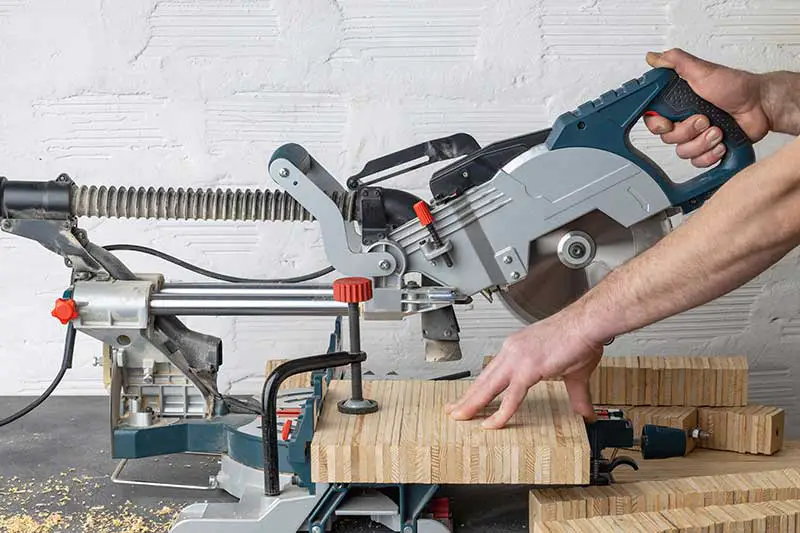To use a miter saw, set up the saw in a suitable workspace, familiarize yourself with its components, and follow safety guidelines. Adjust the miter gauge for the desired angle, secure the workpiece, and make the cut by lowering the saw handle slowly.

A miter saw is a versatile power tool that is essential for making precise angled cuts in woodworking projects. In this guide, we’ll explain the steps to safely and effectively use a miter saw, covering setup, basic cuts, and advanced techniques.
Understanding Your Miter Saw
Before you start using your miter saw, familiarize yourself with its key components and features:
- Power Switch: This activates the saw’s motor and blade rotation.
- Blade Guard: A safety feature that covers the blade when not in use.
- Fence: Provides support for the workpiece and ensures accurate cuts.
- Table: The flat surface where the workpiece is placed.
- Miter Gauge: Allows you to adjust the cutting angle across the width of the workpiece.
- Bevel Adjustment: For miter saws with bevel capabilities, this allows you to adjust the cutting angle along the thickness of the workpiece.
Setting Up Your Miter Saw
Follow these steps to set up your miter saw:
- Choose a Suitable Workspace: Place your miter saw on a stable, level surface with adequate lighting and ventilation.
- Secure the Miter Saw: If using a portable stand, secure the saw to the stand using clamps or bolts. If using a workbench, ensure the saw is firmly in place and won’t move during operation.
- Attach the Dust Collection System: Connect the dust bag or a shop vacuum to the saw’s dust port to maintain a clean workspace.
- Plug in the Miter Saw: Connect the saw to a grounded electrical outlet.
Basic Miter Saw Usage
Follow these steps for making basic miter cuts:
- Mark the Workpiece: Use a pencil and a square to mark the cutting line on the workpiece.
- Adjust the Miter Gauge: Set the desired angle on the miter gauge by loosening the miter lock handle, moving the gauge, and tightening the handle to lock the angle.
- Secure the Workpiece: Place the workpiece against the fence and table, ensuring it’s properly aligned with the cutting line. Use clamps, if necessary, to hold the workpiece in place.
- Put on Safety Gear: Wear eye and ear protection before starting the saw.
- Start the Miter Saw: Turn on the saw and let the blade reach full speed before cutting.
- Make the Cut: Lower the saw handle slowly, allowing the blade to cut through the workpiece along the marked line. Once the cut is complete, release the power switch and wait for the blade to stop before raising the saw handle.
Advanced Miter Saw Techniques
For more complex woodworking projects, you may need to make bevel cuts, compound cuts, or use a sliding miter saw. Here’s how to make these advanced cuts:
- Bevel Cuts: Adjust the bevel angle using the bevel adjustment, and follow the same cutting steps as with basic miter cuts.
- Compound Cuts: Set both the miter and bevel angles, and proceed with the cutting steps as usual.
- Sliding Miter Saw Cuts: For wider workpieces, use a sliding miter saw. Start with the saw head fully extended, and after the blade reaches full speed, lower the handle and push the saw head towards the fence as it cuts through the workpiece.
| Technique | Definition | Applications |
|---|---|---|
| Miter Cut | Angled cut across the width of the workpiece | Picture frames, molding, trim |
| Bevel Cut | Angled cut along the thickness of the workpiece | Baseboards, crown molding |
| Compound Cut | Combination of miter and bevel cuts | Complex trim work, 3D woodworking projects |
| Sliding Miter Cut | Miter or compound cut using a sliding miter saw | Wide workpieces, such as boards and panels |
Conclusion
Using a miter saw effectively requires understanding its components, setting it up properly, and following safe cutting practices. By mastering basic miter cuts and advanced techniques like bevel, compound, and sliding miter cuts, you’ll be well-equipped to tackle a variety of woodworking projects. Always prioritize safety, and ensure your workspace is well-lit, clean, and well-ventilated.
